Have you ever wanted to visit Italy? Then the Cathedral Milan is a must-see for any traveler visiting the city. It’s one of the most beautiful churches in all of Europe and has been standing since 1386!
The Cathedral Milan is one of the most iconic buildings in Italy and has been around for centuries, so it’s no wonder that people from all over visit this cathedral to see its beauty first-hand.
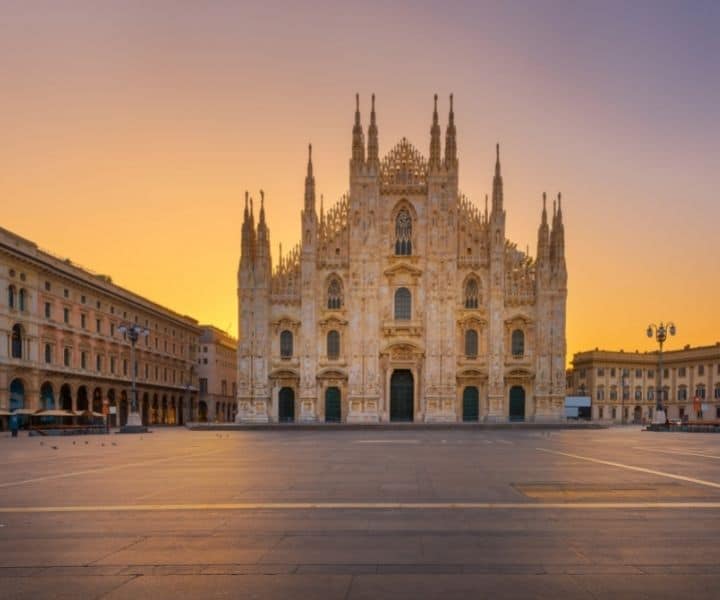
If you want to learn more about this historic cathedral, keep reading.
The Origins of Il Duomo Milan
Milan Cathedral (Duomo di Milano) is the world’s third-largest church, with a construction time of about six centuries.
The Basilica di Santa Maria del Fiore (Saint Mary of the Flower), also known as the Duomo because of the massive octagonal dome on its east end, is Florence’s Cathedral and probably the cradle of the Renaissance.
Santa Maria Novella, Santa Croce, and the Brancacci Chapel are among the numerous Roman Catholic churches in Florence associated with the Renaissance. The Duomo, on the other hand, is the seat of the Roman Catholic Archdiocese of Florence, which dates back to 394 CE.
Although the building of the Milan Duomo began in 1296, it was not completed until 1436, when the structure that bears its name was completed. As a result, for more than a century, the east end of the church was exposed to the elements or covered with low, unstable roofing.
Engineers and Milan Cathedral architects were intimidated by the massive octagonal shape. An example is the Pantheon in Rome, an Italian architect’s familiarity with circular domed designs. Those domes, on the other hand, were made of concrete. Concrete’s recipe had been unknown since the Middle Ages.
Flying buttresses supported the great stone weight of medieval gothic churches like Notre Dame de Paris in France. However, architects and engineers throughout the Renaissance were adamant about not using extravagant Gothic style or flying buttresses, preferring instead to return to their Roman forefathers’ primary, clean lines.
Filippo Brunelleschi, an architect, devised a solution. The Milan Duomo consists of two domes. Sandstone and marble make up the inner dome. The outer dome is built of bricks, each one meticulously designed, molded, and fired to support the dome. The dome was built without any supporting structures beneath it.
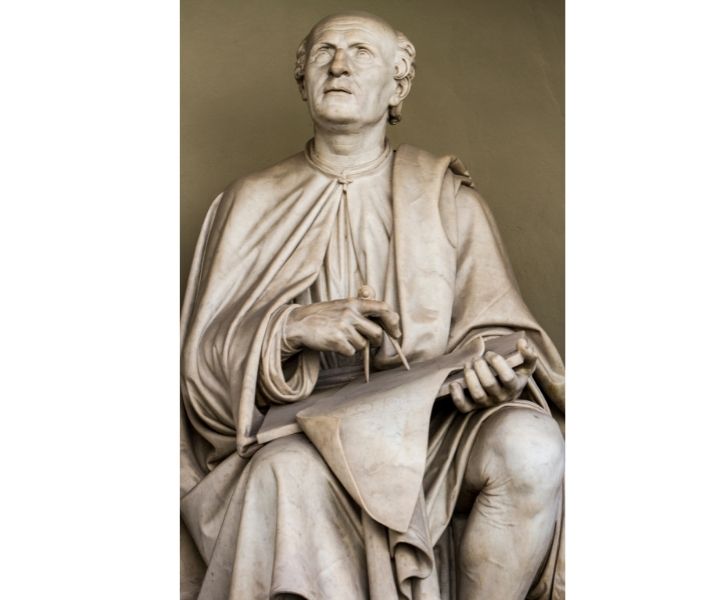
Brunelleschi became the most famous Renaissance architect as a result of Duomo’s initial success.
The Cathedral’s marble facade was only completed in the late 1800s, during an era when medieval, rather than Renaissance, art was popular. As a result, the Renaissance’s birthplace has a medieval look to it.
The Rich History of Cathedral Milan
In the early fifth century, Saint Ambrose built a new basilica on this site, with an accompanying basilica completed in 836. When both buildings were destroyed by fire in 1075, they were reconstructed as the Duomo.
Archbishop Antonio da Saluzzo started construction on the Milan Cathedral in 1386. Nicolas de Bonaventure, a French head engineer, was appointed in 1389, and the church’s Rayonnant Gothic, a French style not typical in Italy, was added.
He decided to cover the brick structure with marble panels. Work moved swiftly, and by 1402, over half of the Cathedral had been completed. However, due to a lack of funds and ideas, construction was nearly completely halted until 1480.
The octagonal dome was completed between 1500 and 1510 under Ludovico Sforza. The Milan Cathedral inside was decorated with four groups of 15 sculptures, each depicting saints, prophets, sibyls, and other Biblical figures.
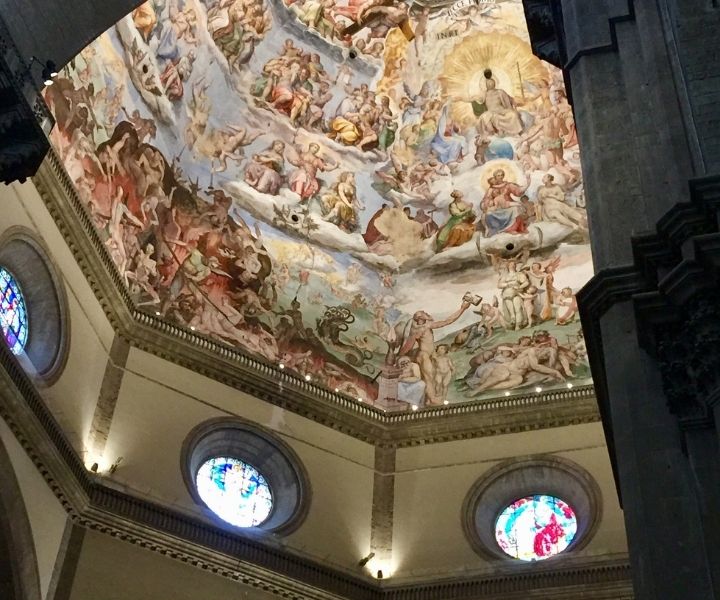
Except for the Guglietto dell’Amadeo (‘Amadeo’s Little Spire,’ built 1507-1510), the exterior remained largely unadorned for a long time. This is a Renaissance masterpiece that blends in nicely with the church’s overall Gothic aspect.
All secular monuments were removed from the Duomo after Carlo Borromeo’s ascent to the archbishop’s throne. The presbytery was renovated in 1575-1585, and new altars and baptistry were constructed.
By 1614, Francesco Brambilla had built wooden choir stalls for the main altar. Borromeo finally consecrated the entire structure as a new church in 1577.
The building of five gateways and two center windows continued until 1638. However, in 1649, the new chief architect Carlo Buzzi made a dramatic change: the façade was restored to its former Gothic architecture, complete with the already finished elements behind giant Gothic pilasters and two massive belfries.
The Madonnina’s spire, which stands at a breathtaking height of 108.5 meters, was erected in 1762 as one of the Cathedral’s principal attractions.
Napoleon Bonaparte commissioned Pellicano to build the façade in 1805. The Cathedral’s façade was finished in only seven years. The majority of the missing arches and spires were constructed over the next few years.
The statues on the southern wall were also completed, and new stained glass windows replaced the previous ones between 1829 and 1858, however, with less artistically pleasing effects. As a result, the Cathedral’s final elements were completed only in the twentieth century, with the last gate being inaugurated on January 6, 1965.
Sites to Behold at the Famous Church in Milan
If you only have time to visit Milan, one place you should make a priority is the Duomo. Milan’s Duomo, which took nearly a century to complete, is regarded as Italy’s largest and most remarkable Gothic structure.
And it is simple to see why the Milan Duomo is regarded as a masterpiece once you have spent some time there. Both the inside and outside the walls of the Duomo were numerous architectural elements to admire.
Thousands of finely carved statues adorn the outside, depicting religious characters and Bible themes, including Jesus’ crucifixion. Its interiors are significantly more complex. Even the flooring is lined with geometric-patterned marble.
But do not overlook the summit. The Duomo’s accessible roof is another feature that distinguishes it. Travelers can get a close look at the Duomo’s magnificent buttresses, pinnacles, and spires while admiring the piazza below.
Also, do not miss the Madonna, who sits on the tallest spire. During World War II, the church covered the gold statue so bombers would not see it.
Six Amazing Facts About The Milan Cathedral
Milan’s Cathedral, or Duomo di Milano in Italian, is the city’s most famous tower and one of Italy’s most distinctive landmarks.
It is possible to tour Milan Cathedral without being aware of any of these things. However, understanding them can help you better comprehend the structure, the blend of styles, some sculptures, and even keep a lookout for some exciting touches!
It is a magnificent structure with a fascinating history: here are some entertaining and interesting facts about Milan’s Cathedral that will enrich your visit.
- The building has more statues than any other in the world
Milan Cathedral is said to have the most sculptures in the world, which makes sense when you see the finely crafted statues on the front, the ones from the spires, and the ones inside. There are 3,400 statues, 700 marble figures, and 135 gargoyles to be found here.
Even if you do not go to the roof, this is one of the reasons you will spend a lot of time at Milan Cathedral. Because, if you take the time to look at all of the statues, you will see that they include not just biblical figures and saints, but also sirens and a depiction of Benito Mussolini.
- It’s the 2nd world catholic church constructed after the Duomo
It is the world’s second-largest Catholic church, behind Rome’s Saint Peter’s Basilica, built after the Duomo. The Cathedral in Milan occupies a whole city block, and its vastness is even more astonishing.
- A red marking indicates the location of a nail from Jesus’ crucifixion
One of Christ’s crucifixion’s three nails can be located in Milan Cathedral. A red light-bulb marks the spot. This nail is extracted and displayed for the public during the Rite of the Nivola, which takes place in mid-September.
- Its looks are the best in the city
You can climb up to the Milan Cathedral roof, which is accessible by steps, and take an elevator to obtain a better perspective of the thriving city beyond and the needle-like spires, which are each capped with a religious symbol.
The Terraza is the major area of the roof. The place is usually full of businesspeople in suits, small children playing games, and canoodling couples. Consider having a rooftop like this as a frequent lunch location.
- The Duomo’s main altar houses Italy’s largest organ
The largest musical organ in Italy is found in the Cathedral in Milan. The Milan Cathedral’s great organ has 15,800 pipes and four organ cases located in the main altar. Some tubes are almost nine meters tall, while the tiniest are only a few centimeters long, making this an instrumental masterpiece.
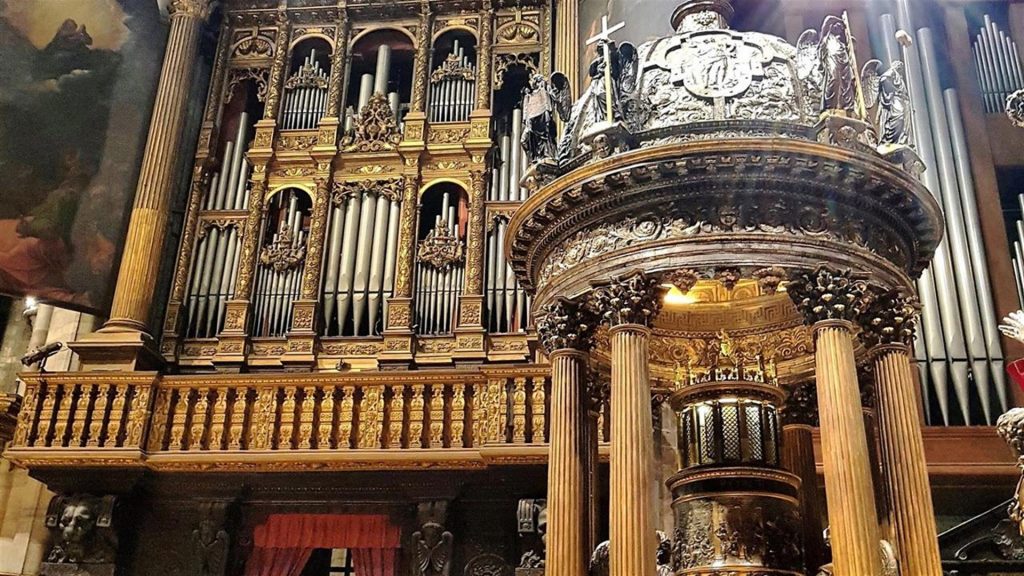
The ornate doors that cover the pipes are works of art in and of themselves, with scenes from the Old and New Testaments adorning them.
- The Duomo was built over six centuries
In 1386, Archbishop Antonio da Saluzzo, with the Lord of Milan, Gian Galeazzo Visconti, began construction on the Cathedral as his patron. The structure was designed by at least 78 different architects from all across Europe, and construction took a long time. Even though the nave was completed, they thought it was time to consecrate the Cathedral in 1418.
Construction continued for the next two centuries, but delays were caused by politics, a shortage of money, and local irritation with a gigantic, apparently interminable project smack-dab in the midst of the city.
A Look Inside the Cathedral Milan
The huge Milan Cathedral is constructed of sizeable darkish marble panels. There are a thousand more sculptures inside, sky-high marble columns, gilded ceilings, dazzling stained glass windows, and many artworks. The attention to detail extends to the floors, which are lined with geometrically patterned marble.
Large murals depicting biblical scenes cover the temple’s walls, and the skeletons of various saints lie in glass caskets throughout the structure, all dressed in their finest garb.
The figure of Bartholomew the Apostle, patron saint of tanners, is one of the Cathedral’s centerpieces. As a nod to his martyrdom, the saint is shown with his skin dangling from his shoulders.
Festivals and Events Relating to Il Duomo Milan
The Holy Nail
The nail from Christ’s cross is taken out of its home in the crucifix on a ceiling vault behind the altar on the Saturday closest to September 14.
The Ritual of the Nivola
The Ritual of the Nivola (in Italian, Rito Della Nivola) is a Catholic liturgical rite that is part of the Ambrosian Rite and a historical reenactment that takes place every year in the Duomo of Milan, Italy.
Carlo Borromeo founded it in the 16th century. It is a commemoration of the “Santo Chiodo” Holy Nail, a nail from the True Cross, and the Archdiocese of Milan’s most precious relic. The relic is also known as the “Santo Morso” Holy Bridle since it is formed like a harness.
It is kept in a case inside a tabernacle in the apse of the Cathedral, some 45 meters above the grotto.
The Holy Week
Because Holy Week and Easter occur in the first or second weeks of the month, April is undoubtedly the most celebrated month in Milan. In April, the city hosts the annual Milan Flower Fair.
A flower market with hundreds of vendors from all over the country was set up along the majestic Navigli canal. The spread of pleasant fragrances and vibrant colors transport you to the spirit of the new season.
Top Reasons to Plan This Milan Church Into Your Next Milan Trip
There are many reasons why you should plan your next trip to Italy with a stop at this cathedral. Here are just a few top reasons!
Witness the illumination of the world’s only holy images from within
The Milan Duomo is the world’s only cathedral with internally lighted windows. Each image conveys a different tale concisely, and if you are like me, you might spend hours delving into each one.
One of the oldest sundials can be used to set your watch
There is a giant sundial on the ground beside the Duomo’s entrance that is as old as the building itself. The astronomers of the Accademia di Brera placed it in 1768, and it is still laser exact today.
Explore the archaeological site beneath the Duomo
Indeed, beneath the Milan Duomo, there is an archaeological site. You must enter the Cathedral and inquire about the location of the place with the guard. The ancient Battistero Paleocristiano is what you would find there. Take a walk around the exhibits and read the descriptions.
Look for the Holy Nail
The red light bulb just above the apse represents the site where one of Jesus’ crucifixion nails was set. Although the bulb is visible throughout the year, the archbishop only brings it down for public viewing on September 14.
Feel the spires for yourself
After reaching the Duomo’s roof, you can literally touch its spires. The building has an elevator, but you can alternatively take the 200-step trek to the top. Pass A is required for the former, whereas Pass B is needed for the latter. If you are lucky enough to arrive on a Sunday, choose Pass B. Climbing slowly and methodically is the most pleasing way to discover the top and the stunning perspective.
See Saint Bartholomew’s statue with flayed skin
The statue of Saint Bartholomew Flayed, brilliantly crafted by Marco d’ Agrate around 1562, is located to the left of the altar. It is the most well-known of all the statues in the Cathedral, and you can see how the saint is shown with flayed skin on his shoulders in the sculpture.
Get a better look at the Virgin Mary
The statue of the famed Madonnina, the Virgin Mary, has been built on the highest and most central of the spires. No building in the city is believed to be taller than this statue, and after you reach the Milan Cathedral roof, you can get a good look at it up close.
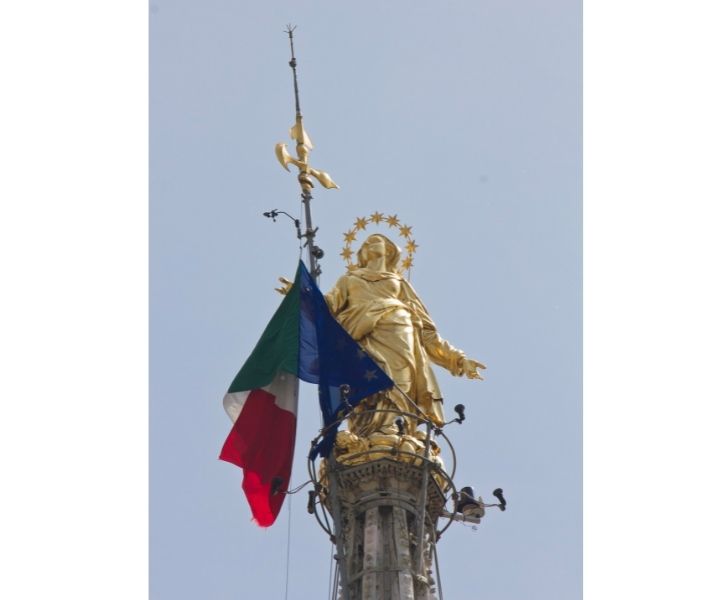
View all 3,400 statues
They total 3,400 sculptures, 700 figures, and 135 gargoyles when the inside and outer sculptures of the Milano duomo are combined. All these features combine to make the structure the most adorned in the world!
Take a look at the altars
Inside the Milan Cathedral, there are three gorgeous altars, each of which is adorned with different artwork or figures. For example, the Visit of Saint Peter to Saint Agatha Jailed by Federico Zuccari and the Trivulzio Candelabrum by Federico Zuccari.
It’s not just the breathtaking architecture that is worth exploring in Milan, but also the culture. The Milan Cathedral has a lot to offer, and if you’re planning a trip to Italy for any reason, this can be your chance to learn more about this famous church in Milan.

Community of passionate writers and content creators who share a love for Italian heritage, culture, travel, food, and the Italian-American community. Our mission is to celebrate Italy’s rich history and traditions and connect with others who share the same passion.

